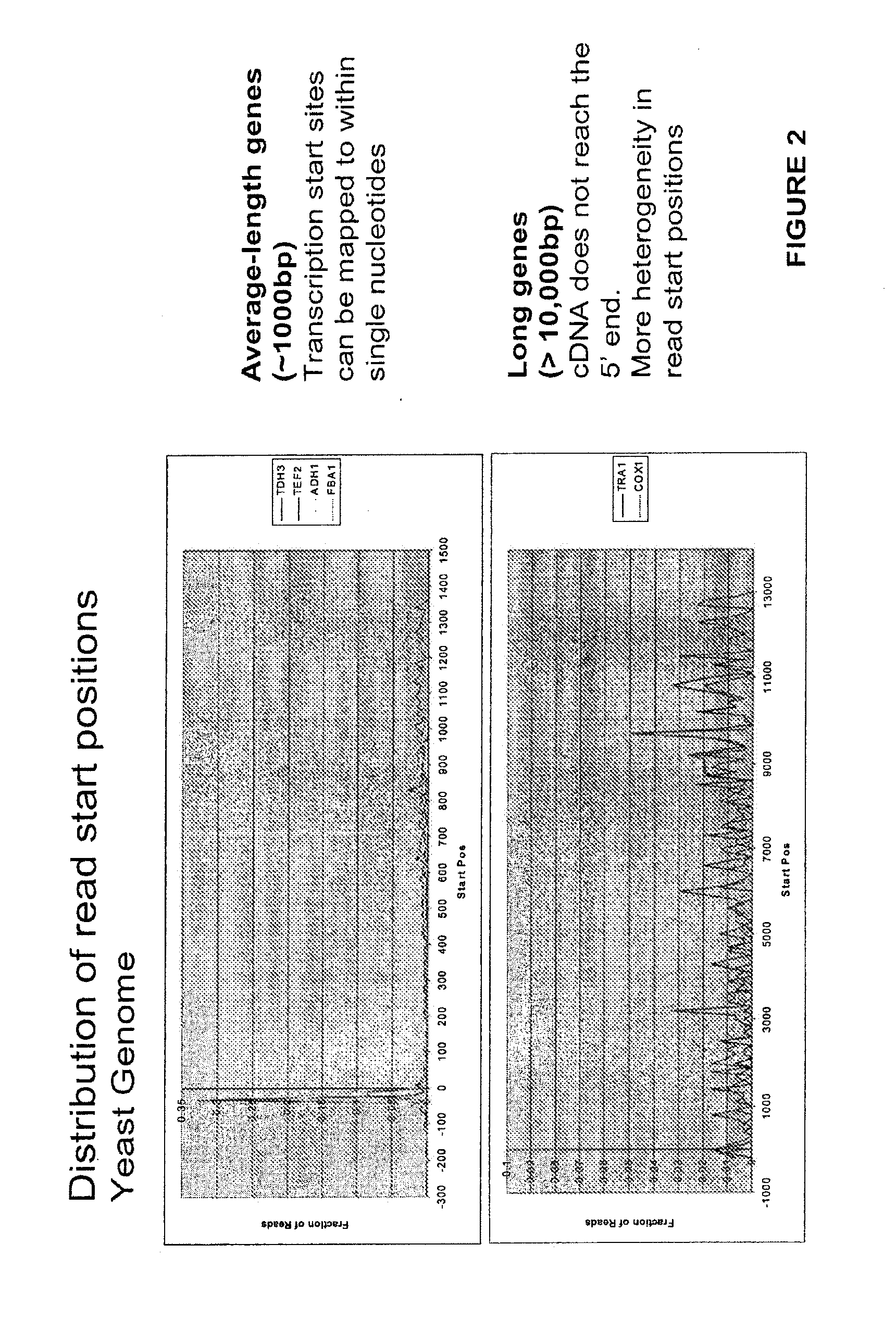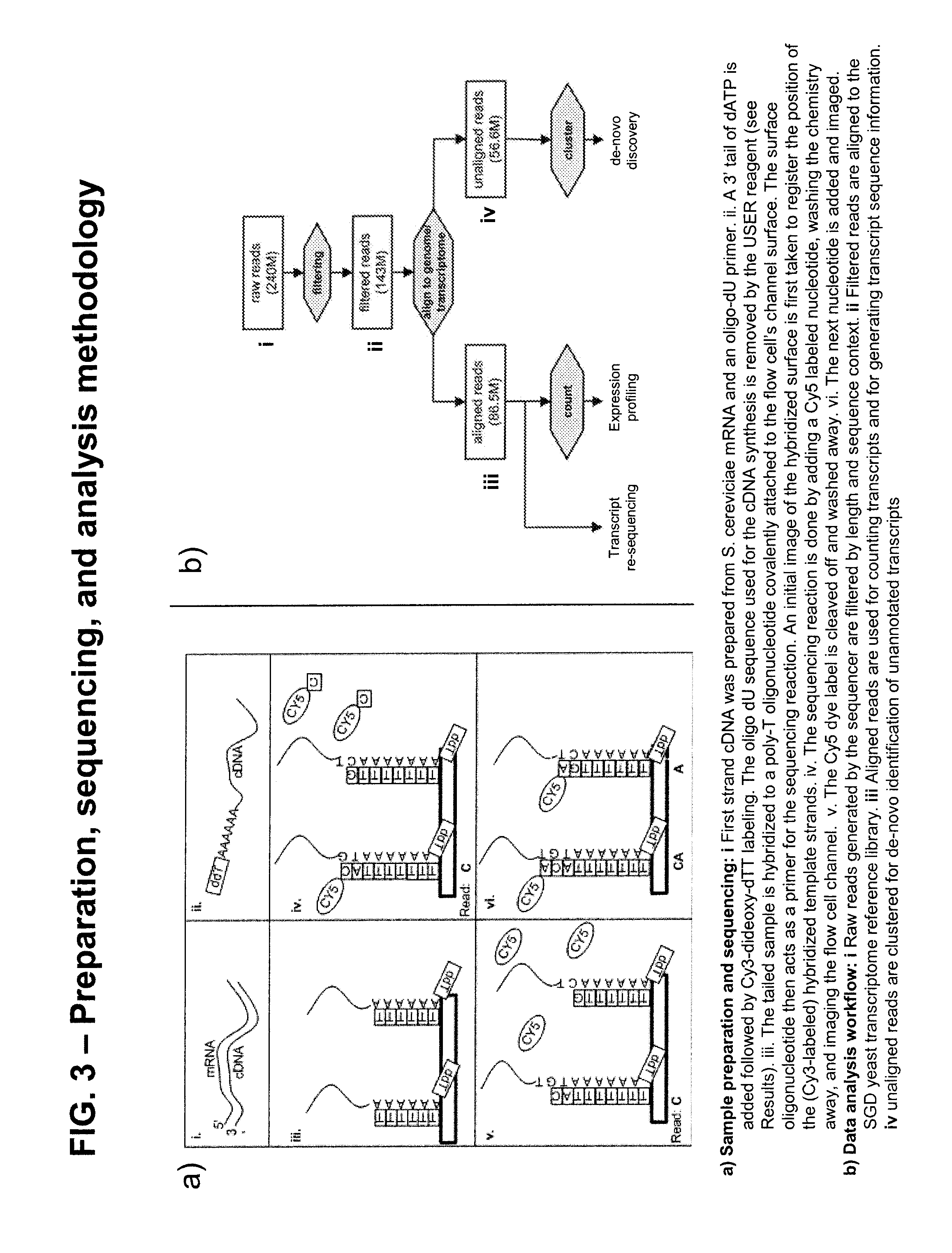Methods for transcript analysis
a transcript analysis and transcript technology, applied in the field of transcript analysis, can solve the problems of inability to discover novel transcripts, limited ability to accurately measure low-addition transcripts, and significant limitations of hybridization-based technologies, so as to increase the accuracy and reliability of results, and coverage and accuracy. high
- Summary
- Abstract
- Description
- Claims
- Application Information
AI Technical Summary
Benefits of technology
Problems solved by technology
Method used
Image
Examples
example 1
[0058]First strand cDNA was made from S. cerevisiae mRNA via oligo-dT priming (Invitrogen SuperScript III kit according to manufacturers instructions). The resulting cDNA was polyadenylated at its 3′ end to yield approximately 50 dATPs. An aliquot of 20 ng of the cDNA sample was combined with KOAc (50 mM), tris base (20 mM), MgAc (10 mM) (for a final concentration of 10%), CoCl (250 μM), dATP (50× the sample molarity), an R110-labeled degradable control oligo used to assess the tailing efficiency (0.5 pmole). The reaction was denatured at 95° C. for 5 minutes and quickly chilled on ice for an additional 2 minutes. 20 U of terminal transferase were then added to the sample mix and incubated at 42° C. for 1 hour followed by a 10 minute enzyme heat inactivation step (70° C.). The polyadenylated cDNA was then hybridized to a surface comprising oligo dT primers (50-mers) as described in co-owned, U.S. Pat. No. 7,282,337, incorporated by reference herein. Sequencing-by-synthesis was carri...
example 2
[0060]In a separate experiment, sequencing reads were obtained as described above from human placenta mRNA sample. Those that did not align to the relevant human placenta reference sequence were clustered based upon sequence similarity and the consensus sequence of the cluster was aligned to the complete NCBI sequence database using BLAST. The sequence was identified as a highly-significant match to an MHC class I antigen from S. scrofa. This is likely a contaminant introduced in sample preparation.
[0061]Further methods and embodiments of the invention are apparent to the skilled artisan upon review of the present disclosure.
example 3
Methods
[0062]cDNA preparation
[0063]mRNA from S. cerevisiae strain DBY746 (his3Δ1 leu2-3 leu2-112 ura3-52 trp1-289), grown under standard conditions (YPD, 30oC) was obtained from Clontech (Mountain View Calif.). 1 μg S. cerevisiae RNA was mixed with 6 in-vitro transcribed Arabidopsis thaliana RNAs at 40 ng to 400 fg as described in FIG. 3 legend (Stratagene, Agilent technologies La Jolla Calif.). In addition 3 assay replicates were prepared independently from the same RNA for assay reproducibility studies. 1 to 2 μg yeast poly A selected RNA was used to make first strand cDNA. First strand cDNA was prepared using a SuperScript III first strand cDNA synthesis kit (Invitrogen, Carlsbad Calif.) according to manufacturers instructions except that 5 μM of a 50 nucleotide deoxyuracil primer (IDT, Iowa City Iowa) was used in place of the recommended primer. mRNA was removed by RNase H (Invitrogen, Carlsbad Calif.) digestion for 20 min. at 37° C. followed by removal of the deoxyuracil primer...
PUM
| Property | Measurement | Unit |
|---|---|---|
| pH | aaaaa | aaaaa |
| depth | aaaaa | aaaaa |
| length | aaaaa | aaaaa |
Abstract
Description
Claims
Application Information
 Login to View More
Login to View More - R&D
- Intellectual Property
- Life Sciences
- Materials
- Tech Scout
- Unparalleled Data Quality
- Higher Quality Content
- 60% Fewer Hallucinations
Browse by: Latest US Patents, China's latest patents, Technical Efficacy Thesaurus, Application Domain, Technology Topic, Popular Technical Reports.
© 2025 PatSnap. All rights reserved.Legal|Privacy policy|Modern Slavery Act Transparency Statement|Sitemap|About US| Contact US: help@patsnap.com



